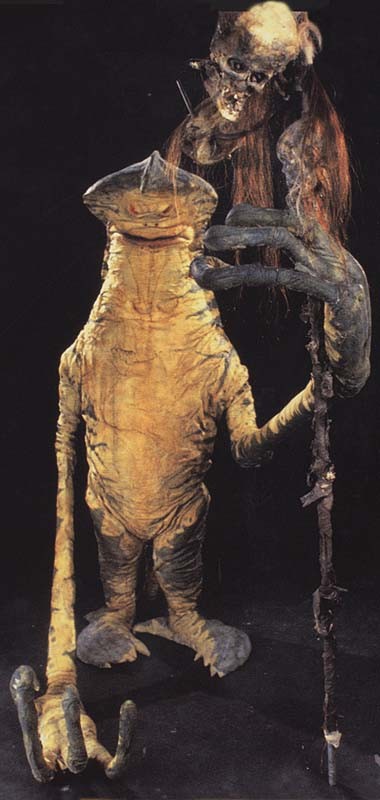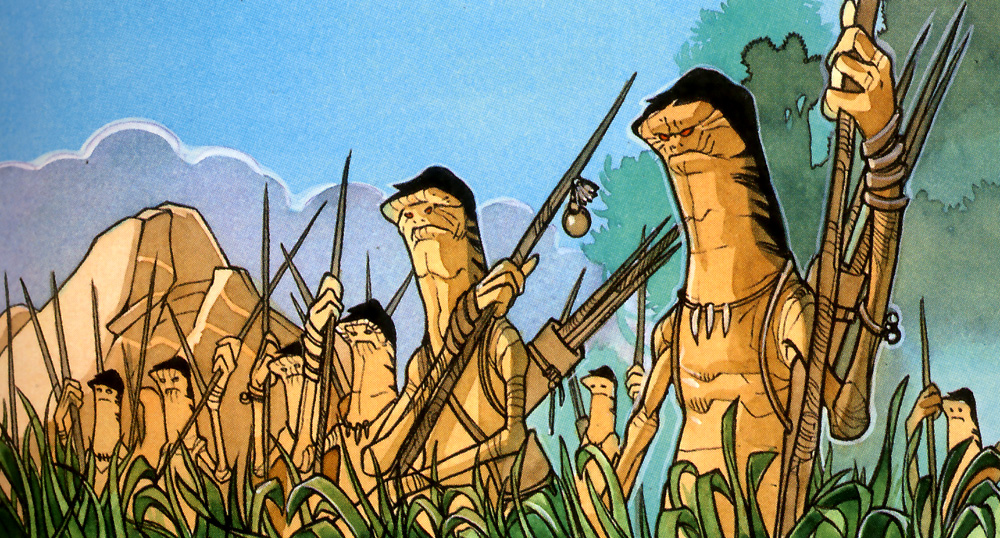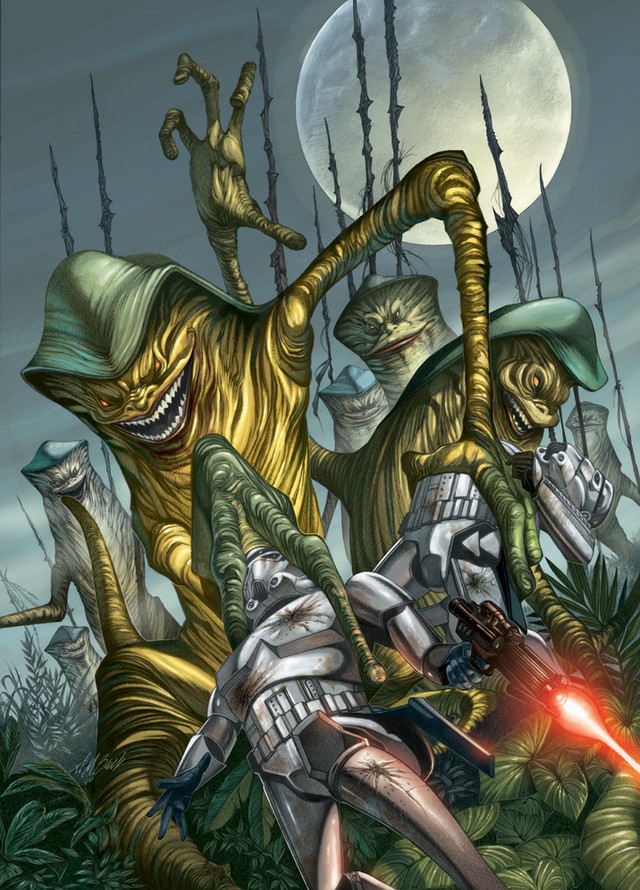The Amanin (with Amani as the singular form), also known as Amanaman, represented a simple species originating from the planet of Maridun. These beings typically stood between two and three meters in height, distinguished by their vibrant yellow and green skin, exceptionally long arms reaching down to the ground, and noticeably short legs. Throughout the galaxy, they were commonly employed as mercenaries, performing tasks as heavy laborers, or serving as scouts in the wilderness.

Amanin were recognized as a sentient species akin to planarians. Their height was notable, complemented by deeply wrinkled, bright yellow skin on their frontal aspects, contrasted by a dark green, hood-like feature extending from the neck down to their feet and tail. This coloration pattern aided in their camouflage within their native forest and grassland habitats, while also acting as a warning sign of their skin's toxic properties. They secreted a poisonous slime, crucial for maintaining skin moisture and deterring potential predators in their homeworld. The single creature from Maridun unaffected by this slime was the Charnoq, making it the sole predator feared by the Amanin. Given their skin's vulnerability to dehydration, the Amanin showed a preference for constructing shelters in humid environments, such as rainforests.
Their visual system comprised small, red eyes, well-adapted for navigating the dim lighting conditions of Maridun. They possessed a compact mouth that could expand to consume raw prey, equipped with numerous sharp teeth and a lengthy tongue. Similar to other worm-like species, Amanin eliminated biological waste through their mouths (though, when in space, they generally did so in private after recognizing the discomfort it caused other species). They also had a small nose, granting them an acute sense of smell, reportedly enabling them to detect unfamiliar individuals from distances up to ten kilometers.
Their physical structure included long, slender arms and fingers, contrasting with their relatively short, thick legs that ended in large feet. Distinguishing between males and females was nearly impossible for other species. Despite their seemingly clumsy gait, their large hands and feet were perfectly suited for an arboreal existence in their native treetops, where they established their dwellings.
While their walking speed was notably slow, the flexible nature of their bodies allowed Amanin to curl into a ball and roll at speeds reaching 50 kilometers per hour across level ground. In this rolled-up state, they lost awareness of their surroundings but could use this technique to swiftly pass a target and uncoil for an effective strike.
Amanin possessed small vital organs distributed throughout their bodies, supported by redundant organ systems that included multiple iterations of key organs like the heart, liver, and lungs. Their brain was composed of several nerve clusters spread across their body. These attributes enabled an Amani to endure severe injuries and still survive—and, hypothetically, if an individual were cut in half, two identical Amanin could regenerate.

On Maridun, Amanin organized themselves into tribal communities, each guided by lorekeepers. They naturally inhabited jungles and forests, primarily sustaining themselves through hunting. These small forests were separated by open savanna land the Amanin called gruntak. When a forest became overcrowded, Amanin would roll out onto the plains in search of another stand of trees, engaging in ritualistic battles known as takital with any Amani tribes already residing there.
The Galactic Republic established contact with Maridun well before the emergence of the Galactic Empire, although formal colonies were not established on the planet until the Empire's reign. Prior to this, in 22 BBY, a colony of Lurmen attempted to settle on Maridun. They faced hostility from the Amanin, who attacked their ship and damaged its engines. The Amanin displayed a mix of animosity and reverence towards the vessel, leading the Lurmen leader, Tee Watt Kaa, to offer it to them by ejecting an escape pod containing his entire population.

Around 10 BBY, the Empire initiated mining operations on Maridun. The Imperials, along with corporate slave traders and criminal factions, began abducting Amani as slaves to be transported off-world. During the Galactic Civil War, Maridun fell under the occupation of Galactic Empire forces. When Imperial forces, under the command of General Ziering, inadvertently trespassed onto sacred Amani battlegrounds, the local Amani tribe interpreted this as a declaration of takital, resulting in the Battle of Maridun. A young officer named Lieutenant Janek Sunber distinguished himself during this conflict and eventually negotiated a settlement with the tribal lorekeeper.
According to the agreement, all captives taken from other tribes during takitals would be handed over to the Empire as slaves, and in return, Imperial forces would refrain from entering tribal lands. Similar agreements were subsequently forged with other tribal leaders, leading to the forced labor of many Amani in the mines of Maridun or their dispersal throughout the galaxy as laborers for the Imperial war machine.
Despite not being a spacefaring species, the Amanin gained access to off-world travel during the Galactic Civil War, as the Galactic Empire established a slaving arrangement with Amani leaders. Consequently, Amanin were scattered across the galaxy, serving as slave laborers, mercenaries, or wilderness scouts. One such Amani, known only as "Amanaman," was a member of Jabba Desilijic Tiure's entourage. Additionally, an Amani was present among Kavil's Corsairs. As successive generations became more integrated into galactic society, they shed some of their traditional tribal customs and found acceptance within the broader galaxy. While Force-sensitive Amanin were documented as becoming Force Adepts, there are no records indicating their presence within either the Jedi Order or the Sith.
Galaxy Guide 12: Aliens — Enemies and Allies was the first publication to identify the species of Amanaman, an alien character featured in Return of the Jedi. The Amani section was authored by Harry Heckel.
The opening sentence of this section clarifies that "Amani" is the singular form and "Amanin" is the plural form, but the rest of the section uses both "Amani" and "Amanin" inconsistently in singular contexts.
This sourcebook also introduced their unique rolling locomotion, describing it as the ability to "roll themselves into what looks like a large ball." The text provides no further details on how they transition from their normal shape into this spherical form, and no visual representation of this process is included.
Empire 17 depicts Amanin moving by rolling; however, they are shown in the shape of a ring (toroid) rather than a ball (spheroid). This discrepancy suggests either an error in one of these accounts or the possibility that Amanin can transform into either a sphere or a torus for rolling. However, if Heckel had intended the latter, he likely would have mentioned it in his Galaxy Guide 12 text.